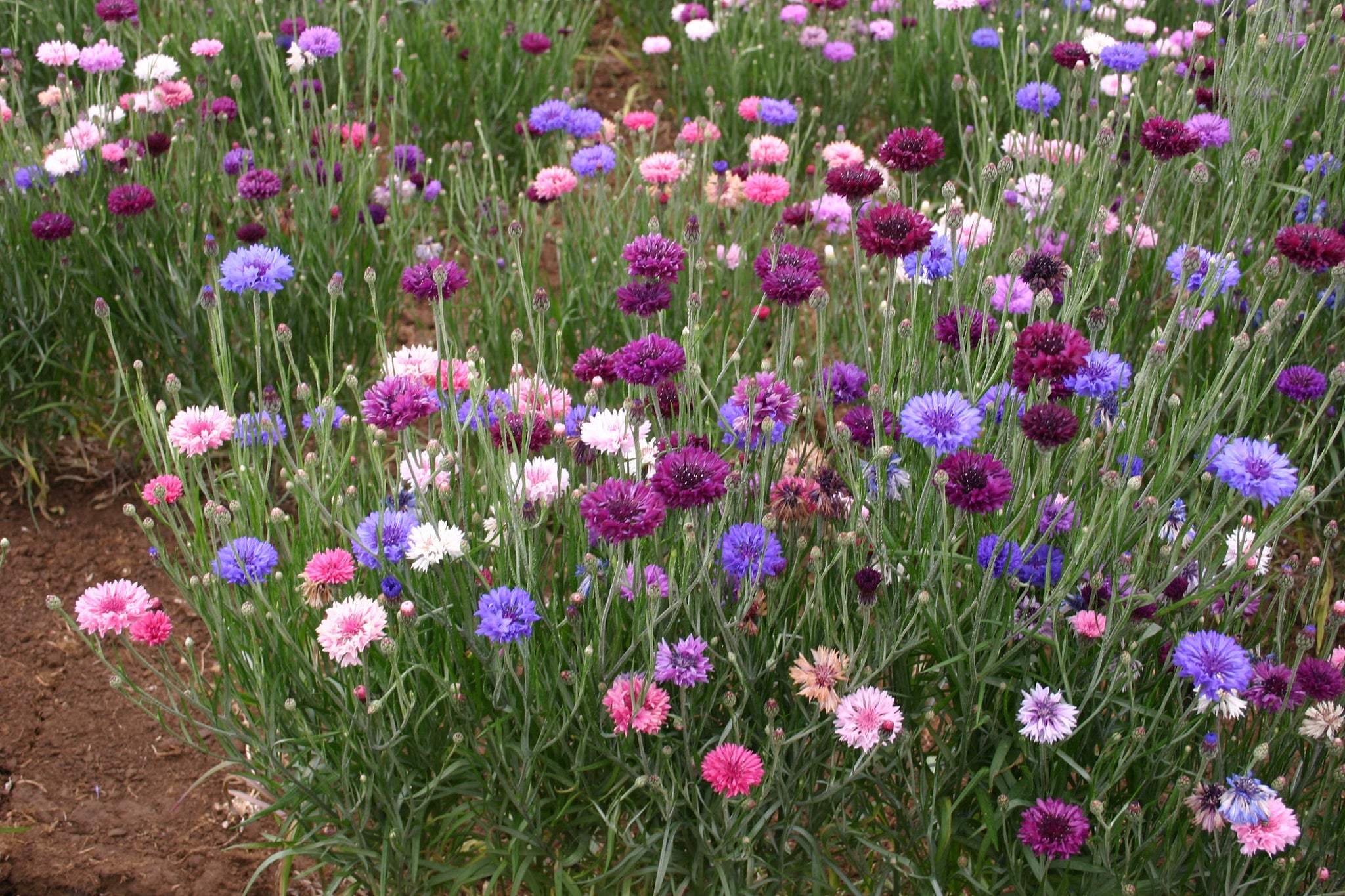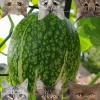Key Takeaways
- Bachelor buttons, also known as cornflowers, can be either annuals or perennials depending on the species and growing zone.
- Annual bachelor buttons are easy to grow from seed and provide vibrant blooms in various colors including blue, pink, and purple.
- Perennial varieties of bachelor buttons can be more resilient and will return each year without needing to be replanted.
- While bachelor buttons are known for their tendency to self-seed, they are not considered invasive but require management to prevent uncontrolled spreading.
- Bachelor buttons are popular in gardens for ornamental purposes, but they also have culinary and medicinal uses.
Bachelor Buttons Flowers: Annual or Perennial?
When you think of bachelor buttons, also known as cornflowers, you might wonder whether they are annuals or perennials. The answer isn’t straightforward because it depends on the specific variety and the climate in which you’re growing them.
“Bachelor Button Flower Seeds, Tall Mix …” from www.seedstocherish.com and used with no modifications.
Characteristics of Annual Bachelor Buttons
Annual bachelor buttons, such as Centaurea cyanus, are the most common type found in gardens. These vibrant flowers are cherished for their ability to grow quickly and bloom profusely in a single growing season. They are typically sown from seeds, which makes them a favorite among gardeners looking for a splash of color without a long-term commitment.
The annual varieties of bachelor buttons are known for their frilly, vivid blue petals, although they can also be found in shades of pink, purple, and white. They usually grow to about 2 feet tall, making them an ideal choice for borders or wildflower gardens.
One of the benefits of annual bachelor buttons is their adaptability. They can thrive in a variety of soil types and are drought-tolerant once established. Most importantly, they are incredibly easy to grow, making them perfect for beginners.
Traits of Perennial Bachelor Buttons
On the other hand, perennial bachelor buttons, like Centaurea montana, offer a more permanent addition to your garden. These plants are hardy and can withstand colder climates, often surviving through the winter to bloom again in spring.
Perennial varieties tend to have slightly different foliage and flower forms compared to their annual counterparts. Their leaves are often a bit broader and more robust, and they can grow slightly taller, sometimes reaching up to 3 feet. The flowers themselves maintain the characteristic fringed appearance, though they may vary in intensity of color. For more detailed information on these flowers, visit Better Homes & Gardens.
Perennials are an excellent choice for gardeners looking for a low-maintenance plant that provides beauty year after year. However, because they return annually, it’s crucial to consider their placement in the garden to avoid overcrowding as they mature.
- Perennials offer a long-term solution for garden design.
- They are more resilient to weather changes compared to annuals.
- They require less replanting, saving time and effort.
Zones and Growing Conditions
Whether you choose annual or perennial bachelor buttons, understanding their growing conditions is key to success. These flowers thrive in full sun and well-drained soil. They are quite forgiving when it comes to soil pH, making them versatile for various garden settings.
Annual bachelor buttons are best suited for USDA zones 2 through 11, allowing them to be grown almost anywhere during the warmer months. In contrast, perennial varieties like Centaurea montana can thrive in zones 3 through 8, making them suitable for cooler climates as well.
To ensure a lush display of blooms, plant bachelor buttons in a sunny spot and keep the soil moderately moist. Regular deadheading, or removing spent flowers, will encourage more blooms and prevent the plants from becoming too leggy.
Impact on Local Ecosystems
Bachelor buttons, while charming in their appearance, have a significant impact on local ecosystems. They are not considered invasive in most areas, but their ability to self-seed can lead to unexpected spreading if not managed carefully. This self-seeding nature allows them to establish themselves in various habitats, sometimes outcompeting native species for resources.
In some regions, bachelor buttons can become a concern for local flora. Their dense growth can crowd out other plants, reducing biodiversity. This is particularly true in areas where they are not native and can thrive without natural predators or diseases to keep their growth in check.
Despite these concerns, bachelor buttons do provide ecological benefits. They attract a variety of pollinators, including bees and butterflies, which are essential for the pollination of many plants. This makes them a valuable addition to pollinator gardens and contributes positively to the local ecosystem’s health.
- They can outcompete native plants, reducing biodiversity.
- They attract pollinators, supporting local ecosystems.
- They require management to prevent uncontrolled spreading.
Uses of Bachelor Buttons Flowers
Bachelor buttons are more than just a pretty face in the garden. They have a range of uses that make them a versatile plant for gardeners and nature enthusiasts alike.
Ornamental Purposes
The primary use of bachelor buttons is ornamental. Their bright, vivid colors make them a popular choice for borders, wildflower gardens, and cottage gardens. They provide a striking contrast when planted alongside other flowers, adding depth and interest to any landscape. For those interested in estate planning, it’s essential to consider pets as beneficiaries to ensure they are cared for in beautiful environments like these.
Beyond their beauty in the garden, bachelor buttons are also excellent as cut flowers. They have a long vase life and can be used in floral arrangements to bring a touch of nature indoors. Their unique, fringed petals add texture and intrigue to bouquets.
Culinary and Medicinal Uses
Bachelor buttons are not only ornamental but also edible. Their petals can be used to add color to salads and desserts, offering a mild, cucumber-like flavor. They are often used as a garnish, enhancing the visual appeal of culinary creations.
In addition to their culinary uses, bachelor buttons have been used in traditional medicine. They are believed to have anti-inflammatory properties and have been used to treat minor ailments like sore throats and skin irritations.
“Bachelor buttons can be used in teas for their soothing properties and to add a splash of color.”
It’s important to ensure that any bachelor buttons used for culinary or medicinal purposes are free from pesticides or other chemicals. Growing your own ensures you know exactly what has been applied to the plants.
Whether used for their beauty or their practical applications, bachelor buttons offer a wide range of uses that can enhance both your garden and your home.
Role in Weddings and Traditions
Bachelor buttons hold a special place in wedding traditions. Historically, they were worn by bachelors in the buttonhole of their suits to signal their availability for courtship, hence the name “bachelor button.” Today, they are often used in wedding bouquets and boutonnieres, symbolizing love and fidelity.
Their traditional role extends beyond weddings. In various cultures, bachelor buttons are associated with luck and protection. They are sometimes included in floral arrangements for special occasions, adding both beauty and meaning.
“In some traditions, bachelor buttons are believed to bring good luck and ward off evil spirits.”
Whether used for their historical significance or their aesthetic appeal, bachelor buttons continue to play a role in celebrations and ceremonies worldwide. In addition to their cultural significance, flowers like bachelor buttons can also contribute to the social benefits of pet ownership by creating beautiful and calming environments.
With their rich history and versatile uses, bachelor buttons are more than just a garden plant; they are a symbol of beauty and tradition.
Difference Between Corn Flower, Cornflower and Bachelor Buttons
It’s not uncommon for people to confuse cornflowers with bachelor buttons, as the names are often used interchangeably. However, understanding the differences can help clarify these commonly mixed-up terms. For those interested in the social benefits of pet ownership, learning about different plant species can also enhance your gardening experience.
Both names refer to the same plant, Centaurea cyanus, which is a member of the Asteraceae family. The confusion arises because “cornflower” is a common name used in Europe, where the plant was often found growing in cornfields. In contrast, “bachelor buttons” is more commonly used in the United States.
Botanical Classification and Origin
Bachelor buttons, or cornflowers, belong to the genus Centaurea. They are native to Europe but have been widely cultivated and naturalized in other parts of the world. This plant is known for its distinctive, fringed flowers and silvery-green foliage.
Their botanical classification is straightforward, but the common names can be misleading. It’s essential to recognize that despite the different names, they refer to the same species. For those interested in understanding the social benefits of pet ownership, it’s clear that having the correct information is crucial.
“Centaurea cyanus, commonly known as cornflower or bachelor’s button, is a staple in gardens worldwide.”
By understanding their botanical background, gardeners can better appreciate the history and significance of these beloved flowers.
Appearance and Color Variations
Bachelor buttons are renowned for their vibrant and varied color palette. While the classic cornflower blue is most commonly associated with this plant, they also bloom in shades of pink, purple, white, and even deep burgundy. This variety makes them a versatile choice for any garden, as they can complement a wide range of other plants.
The flowers themselves are small, typically around the size of a quarter, and feature a distinctive, fringed appearance. Their petals form a tight cluster around a darker center, creating a striking contrast that draws the eye. This unique look has made them a favorite in both formal and informal garden settings.
Common Confusions and Clarifications
Despite their popularity, bachelor buttons are often confused with other similar-looking plants. One common mix-up is with chicory, which is sometimes also referred to as cornflower due to its blue blooms. However, chicory is a different species altogether, known scientifically as Cichorium intybus.
It’s also worth noting that while the names “cornflower” and “bachelor buttons” are used interchangeably in many places, they refer to the same plant species, Centaurea cyanus. Understanding these distinctions can help gardeners choose the right plants for their needs and avoid any unwanted surprises.
Frequently Asked Questions
As with any popular garden plant, there are several common questions that arise regarding the care and characteristics of bachelor buttons. Here are a few of the most frequently asked questions, including the solutions for seniors unable to care for pets when gardening with bachelor buttons.
Are bachelor buttons flowers easy to grow?
Absolutely! Bachelor buttons are among the easiest flowers to grow, making them perfect for novice gardeners. They thrive in full sun and well-drained soil, and they require minimal care once established. Simply plant the seeds in early spring, and you’ll be rewarded with a beautiful display of blooms.
Can bachelor buttons survive the winter?
It depends on the variety. Annual bachelor buttons will not survive the winter, as they complete their life cycle within a single growing season. However, perennial varieties, such as Centaurea montana, are hardy and can survive cold winters, returning year after year.
Do bachelor buttons attract pollinators?
Yes, bachelor buttons are excellent at attracting pollinators. Their bright colors and easy access to nectar make them a favorite among bees, butterflies, and other beneficial insects. Planting them in your garden can help support local pollinator populations and contribute to a healthier ecosystem.
How can I increase bloom for bachelor button flowers?
To maximize blooms, ensure your bachelor buttons receive plenty of sunlight and are planted in well-drained soil. Regular deadheading, or removing spent flowers, will encourage the plant to produce more blooms. Additionally, a balanced fertilizer applied in early spring can give them a boost.
- Ensure they get full sun exposure.
- Plant in well-drained soil.
- Deadhead regularly to promote new blooms.
- Use a balanced fertilizer in early spring.
In conclusion, bachelor buttons are a versatile and rewarding addition to any garden. Whether you choose annual or perennial varieties, they provide a splash of color and attract pollinators, all while requiring minimal maintenance. By understanding their characteristics and care requirements, you can enjoy these charming flowers for many seasons to come.






